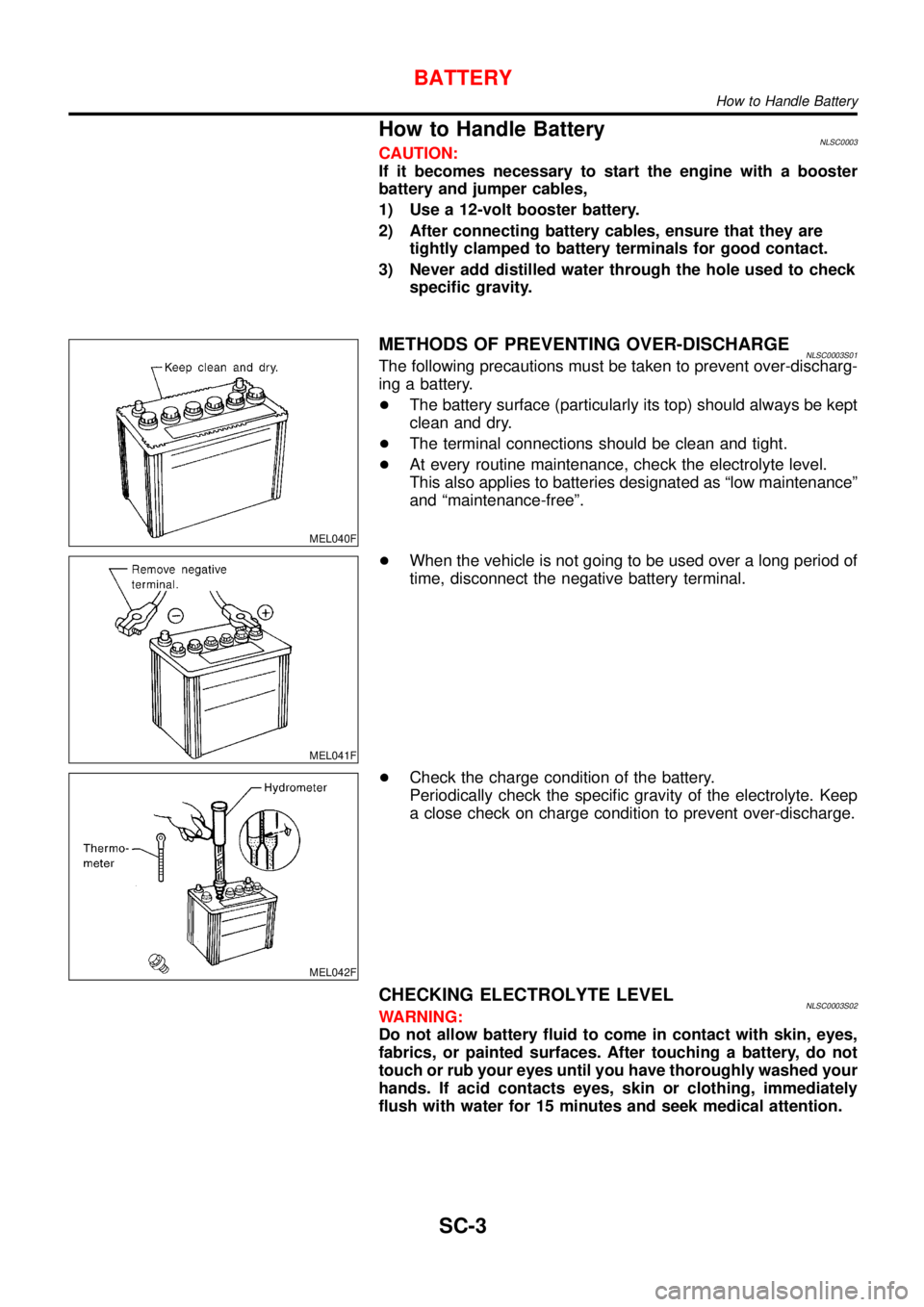2001 NISSAN ALMERA TINO battery
[x] Cancel search: batteryPage 2940 of 3051

Diagnostic item ExplanationRepair order
“Recheck SRS at each replace-
ment.”
CONTROL UNIT+Low battery voltage (Less than 9V)+Go to DIAGNOSTIC PROCEDURE
3 (RS-42) after charging battery.
+Diagnosis sensor unit is malfunctioning. 1. Visually check the wiring harness
connection.
2. Replace the harness if it has visible
damage.
3. Replace diagnosis sensor unit.
4. Replace the related harness.
* Follow the procedures in numerical order when repairing malfunctioning parts. Confirm whether malfunction is eliminated
using the air bag warning lamp or CONSULT-II each time repair is finished. If malfunction is still observed, proceed to the next
step. When malfunction is eliminated, further repair work is not required.
NRS122
DIAGNOSTIC PROCEDURE 3NLRS0048S02Final checking after repairing SRS by using CONSULT-II—
Diagnosis mode
1. After repairing SRS, connect both battery cables.
2. Connect CONSULT-II to data link connector.
3. Turn ignition switch from“OFF”to“ON”.
SRS695
4. Touch“START”.
C2SSE01
5. Touch“AIR BAG”.
SUPPLEMENTAL RESTRAINT SYSTEM (SRS)
Trouble Diagnoses with CONSULT-II (Cont’d)
RS-49
Page 2944 of 3051

10. Touch“PRINT”.
11. Compare diagnostic codes to“Intermittent Malfunction Diag-
nostic Code Chart”, page RS-53.
12. Touch“BACK”key of CONSULT-II until“SELECT SYSTEM”
appears.
13. Turn ignition switch“OFF”, then turn off and disconnect
CONSULT-II, and disconnect both battery cables.
14. Repair the system as outlined by the“Repair order”in“Inter-
mittent Malfunction Diagnostic Code Chart”, that corresponds
to the self-diagnostic result. For replacement procedure of
component parts, refer to RS-21.
15. Go to DIAGNOSTIC PROCEDURE 3, page RS-49, for final
checking.
INTERMITTENT MALFUNCTION DIAGNOSTIC CODE
CHART (“SELF-DIAG [PAST] or TROUBLE DIAG
RECORD”)
NLRS0048S0402
Diagnostic item Explanation Repair order
NO DTC IS DETECTED+No malfunction is detected.+Go to DIAGNOSTIC PROCEDURE 3
(RS-49).
AIRBAG MODULE
[OPEN]+Driver air bag module circuit is open.
(including the spiral cable)1. Visually check the wiring harness con-
nection.
2. Replace the harness if it has visible
damage.
3. If the harness check is OK, replace the
spiral cable, diagnosis sensor unit and
driver air bag module. (Before dispos-
ing the driver air bag module, it must
be deployed.) AIRBAG MODULE
[VB-SHORT]+Driver air bag module circuit is shorted
to some power supply circuit. (including
the spiral cable)
AIRBAG MODULE
[GND-SHORT]+Driver air bag module circuit is shorted
to ground. (including the spiral cable)
AIRBAG MODULE
[SHORT]+Driver air bag module circuits are
shorted to each other.
ASSIST A/B MODULE
[VB-SHORT]+Front passenger air bag module circuit
is shorted to some power supply cir-
cuit.1. Visually check the wiring harness con-
nection.
2. Replace the harness if it has visible
damage.
3. If the harness check is OK, replace the
diagnosis sensor unit and passenger
air bag module. (Before disposing the
passenger air bag module, it must be
deployed.) ASSIST A/B MODULE
[OPEN]+Front passenger air bag module circuit
is open.
ASSIST A/B MODULE
[GND-SHORT]+Front passenger air bag module circuit
is shorted to ground.
ASSIST A/B MODULE
[SHORT]+Front passenger air bag module cir-
cuits are shorted to each other.
SIDE MODULE LH
[OPEN]+Front LH side air bag module circuit is
open.1. Visually check the wiring harness con-
nection.
2. Replace the harness if it has visible
damage.
3. If the harness check is OK, replace the
diagnosis sensor unit and front LH side
air bag module. (Before disposing the
front LH side air bag module, it must
be deployed.) SIDE MODULE LH
[VB-SHORT]+Front LH side air bag module circuit is
shorted to some power supply circuits.
SIDE MODULE LH
[GND-SHORT]+Front LH side air bag module circuit is
shorted to ground.
SIDE MODULE LH
[SHORT]+Front LH side air bag module circuits
are shorted to each other.
SUPPLEMENTAL RESTRAINT SYSTEM (SRS)
Trouble Diagnoses with CONSULT-II (Cont’d)
RS-53
Page 2946 of 3051

SRS800
Trouble Diagnoses without CONSULT-II=NLRS0049DIAGNOSTIC PROCEDURE 6NLRS0049S01Inspecting SRS malfunctioning parts by using“AIR BAG”
warning lamp—Diagnosis mode
NOTE:
SRS will not enter Diagnosis mode if no malfunction is
detected in User mode.
1. Turn ignition switch“ON”.
2. After“AIR BAG”warning lamp lights for 7 seconds, turn igni-
tion switch“OFF”within 1 second.
3. Wait more than 3 seconds.
4. Repeat steps 1 to 3 three times.
5. Turn ignition switch“ON”.
SRS is now in Diagnosis mode.
6.“AIR BAG”warning lamp operates in Diagnosis mode as fol-
lows:
NOTE:
If SRS does not enter Diagnosis mode even though malfunction is
detected in User mode, check the battery voltage.
If the battery voltage is less than 9V, charge the battery. Then go
to DIAGNOSTIC PROCEDURE 7, page RS-60.
If the battery voltage is OK, replace the diagnosis sensor unit.
SUPPLEMENTAL RESTRAINT SYSTEM (SRS)
Trouble Diagnoses without CONSULT-II
RS-55
Page 2947 of 3051

No.“AIR BAG”warning lamp flash pattern—Diagnosis mode—SRS condition
1
SRS333
athroughbare repeated.+Diagnosis
results (pre-
viously
stored in
the
memory)
might not
be erased
after repair.
+Intermittent
malfunction
has been
detected in
the past.
Go to DIAG-
NOSTIC PRO-
CEDURE 8
(RS-62).
2
SRS341
athroughdare repeated.
b—Driver and front passen-
ger air bag and front seat belt
pre-tensioner marker (For iden-
tifying driver air bag, front pas-
senger air bag and/or front seat
belt pre-tensioners malfunction-
ing)
d—Indicates malfunctioning
part. The number of flash var-
ies with malfunctioning part
(0.5 sec. ON and 0.5 sec. OFF
is counted as one flash.)The system is
malfunctioning
and needs to
be repaired.
3
SRS342-A
athroughfare repeated.
b,c,d—Front side air bag
marker (For identifying front
side air bag malfunctioning)
f—Indicates malfunctioning
part. The number of flash var-
ies with malfunctioning part
(0.5 sec. ON and 0.5 sec. OFF
is counted as one flash.)
7. Malfunctioning part is indicated by the number of flashes (part
dorf). Compare the number of flashes to“Air Bag Warning
Lamp Flash Code Chart”, page RS-57, and locate malfunction-
ing part.
8. Turn ignition switch“OFF”, and disconnect both battery cables.
9. Repair the system as outlined by the“Repair order”in“Warn-
ing Lamp Flash Code Chart”that corresponds to the flash
code. For replacement procedure of component parts, refer to
RS-21.
10. After repairing the system, go to DIAGNOSTIC PROCEDURE
7, page RS-60.
SUPPLEMENTAL RESTRAINT SYSTEM (SRS)
Trouble Diagnoses without CONSULT-II (Cont’d)
RS-56
Page 2951 of 3051

The LH side air bag (sat-
ellite) sensor is malfunc-
tioning.
(f: 4 flashes)Flash pattern
SRS339-A
athroughfare repeated.
f—Four flashes indi-
cate malfunctioning LH
side air bag (satellite)
sensor circuit.
Repair order (“Recheck SRS at each replacement.”)
1. Visually check the wiring harness connection.
2. Replace the harness if it has visible damage.
3. Replace the LH side air bag (satellite) sensor.
4. Replace the diagnosis sensor unit.
5. Replace the related harness.
* Follow the procedures in numerical order when repairing malfunctioning parts. Confirm whether malfunction is eliminated
using the air bag warning lamp or CONSULT-II each time repair is finished. If malfunction is still observed, proceed to the next
step. When malfunction is eliminated, further repair work is not required.
SRS800
DIAGNOSTIC PROCEDURE 7NLRS0049S02Final checking after repairing SRS by using“AIR BAG”warn-
ing lamp—Diagnosis mode and User mode
1. After repairing SRS connect both battery cables.
2. Open driver’s door.
3. Turn ignition switch from“OFF”to“ON”.
4.“AIR BAG”warning lamp operates in Diagnosis mode as fol-
lows:
SUPPLEMENTAL RESTRAINT SYSTEM (SRS)
Trouble Diagnoses without CONSULT-II (Cont’d)
RS-60
Page 2962 of 3051

STARTING & CHARGING SYSTEMS
SECTION
SC
CONTENTS
PRECAUTIONS...............................................................2
Supplemental Restraint System (SRS)″AIR
BAG″and″SEAT BELT PRE-TENSIONER″...............2
Wiring Diagrams and Trouble Diagnoses....................2
BATTERY.........................................................................3
How to Handle Battery ................................................3
METHODS OF PREVENTING OVER-DISCHARGE......3
CHECKING ELECTROLYTE LEVEL............................3
SPECIFIC GRAVITY CHECK......................................4
Battery Test and Charging Chart .................................6
CHART I...................................................................6
CHART II..................................................................7
A: SLOW CHARGE....................................................8
B: STANDARD CHARGE..........................................10
C: QUICK CHARGE................................................. 11
STARTING SYSTEM.....................................................13
System Description ....................................................13
M/T MODELS..........................................................13
A/T MODELS...........................................................13
Wiring Diagram - START -.........................................14
MODELS WITH FUSE AND FUSIBLE LINK BOX
E43
.........................................................................14
MODELS WITH FUSE AND FUSIBLE LINK BOX
E90
.........................................................................15
Trouble Diagnoses.....................................................16
Construction ...............................................................17
Removal and Installation ...........................................19
REMOVAL...............................................................19
INSTALLATION........................................................20
Inspection...................................................................20
MAGNETIC SWITCH CHECK...................................20
PINION/CLUTCH CHECK.........................................20
BRUSH CHECK.......................................................20
YOKE CHECK.........................................................21
ARMATURE CHECK................................................22
Assembly ...................................................................23
PINION PROTRUSION LENGTH ADJUSTMENT........23
CHARGING SYSTEM....................................................24
System Description ....................................................24
Wiring Diagram - CHARGE -.....................................25
MODELS WITH FUSE AND FUSIBLE LINK BOX
E43
.........................................................................25
MODELS WITH FUSE AND FUSIBLE LINK BOX
E90
.........................................................................26
Trouble Diagnoses.....................................................27
WITH IC REGULATOR.............................................27
MALFUNCTION INDICATOR....................................27
Construction ...............................................................28
Removal and Installation ...........................................30
REMOVAL (SR ENGINE)..........................................30
REMOVAL (QG ENGINE).........................................30
REMOVAL (YD ENGINE)..........................................30
INSTALLATION........................................................30
Disassembly...............................................................31
REAR COVER.........................................................31
REAR BEARING......................................................31
Inspection...................................................................31
ROTOR CHECK......................................................31
BRUSH CHECK.......................................................32
STATOR CHECK.....................................................32
Assembly ...................................................................32
RING FITTING IN REAR BEARING...........................32
REAR COVER INSTALLATION.................................33
SERVICE DATA AND SPECIFICATIONS (SDS).........34
Battery........................................................................34
Starter ........................................................................34
Alternator ...................................................................34
Page 2964 of 3051

How to Handle BatteryNLSC0003CAUTION:
If it becomes necessary to start the engine with a booster
battery and jumper cables,
1) Use a 12-volt booster battery.
2) After connecting battery cables, ensure that they are
tightly clamped to battery terminals for good contact.
3) Never add distilled water through the hole used to check
specific gravity.
MEL040F
METHODS OF PREVENTING OVER-DISCHARGENLSC0003S01The following precautions must be taken to prevent over-discharg-
ing a battery.
+The battery surface (particularly its top) should always be kept
clean and dry.
+The terminal connections should be clean and tight.
+At every routine maintenance, check the electrolyte level.
This also applies to batteries designated as“low maintenance”
and“maintenance-free”.
MEL041F
+When the vehicle is not going to be used over a long period of
time, disconnect the negative battery terminal.
MEL042F
+Check the charge condition of the battery.
Periodically check the specific gravity of the electrolyte. Keep
a close check on charge condition to prevent over-discharge.
CHECKING ELECTROLYTE LEVELNLSC0003S02WARNING:
Do not allow battery fluid to come in contact with skin, eyes,
fabrics, or painted surfaces. After touching a battery, do not
touch or rub your eyes until you have thoroughly washed your
hands. If acid contacts eyes, skin or clothing, immediately
flush with water for 15 minutes and seek medical attention.
BATTERY
How to Handle Battery
SC-3
Page 2965 of 3051

MEL043F
+Remove the cell plug using a suitable tool.
+Add distilled water up to the MAX level.
SEL709E
SulphationNLSC0003S0201A battery will be completely discharged if it is left unattended
for a long time and the specific gravity will become less than
1.100. This may result in sulphation on the cell plates.
To determine if a battery has been“sulphated”, note its volt-
age and current when charging it. As shown in the figure, less
current and higher voltage are observed in the initial stage of
charging sulphated batteries.
A sulphated battery may sometimes be brought back into ser-
vice by means of a long, slow charge, 12 hours or more, fol-
lowed by a battery capacity test.
MEL042FA
SPECIFIC GRAVITY CHECKNLSC0003S031. Read hydrometer and thermometer indications at eye level.
2. Convert into specific gravity at 20°C (68°F).
Example:
+When electrolyte temperature is 35°C (95°F) and specific grav-
ity of electrolyte is 1.230, converted specific gravity at 20°C
(68°F) is 1.240.
+When electrolyte temperature is 0°C (32°F) and specific grav-
ity of electrolyte is 1.210, converted specific gravity at 20°C
(68°F) is 1.196.
BATTERY
How to Handle Battery (Cont’d)
SC-4